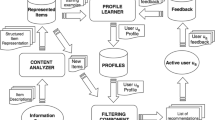Abstract
Commercial recommender systems use various data mining techniques to make appropriate recommendations to users during online, real-time sessions. Published algorithms focus more on the discrete user ratings instead of binary results, which hampers their predictive capabilities when usage data is sparse. The system proposed in this paper, e-VZpro, is an association mining-based recommender tool designed to overcome these problems through a two-phase approach. In the first phase, batches of customer historical data are analyzed through association mining in order to determine the association rules for the second phase. During the second phase, a scoring algorithm is used to rank the recommendations online for the customer. The second phase differs from the traditional approach and an empirical comparison between the methods used in e-VZpro and other collaborative filtering methods including dependency networks, item-based, and association mining is provided in this paper. This comparison evaluates the algorithms used in each of the above methods using two internal customer datasets and a benchmark dataset. The results of this comparison clearly show that e-VZpro performs well compared to dependency networks and association mining. In general, item-based algorithms with cosine similarity measures have the best performance.
Similar content being viewed by others
References
Ali, K., Manganaris, S., and Srikant, R. 1997. Partial classification using association rules. In Proceeding of Third International Conference on Knowledge Discovery in Databases and Data Mining. Heckerman, D., Mannila, H., Pregibon, D., and Uthurusamy, R. (Eds.). AAAI Press, pp. 115–118.
Billsus, D. and Pazzani, M.J. 1998. Learning collaborative information filters. In Proceedings of the 1998 Workshop on Recommender Systems. AAAI Press.
Breese, J., Heckerman, D., and Kadie, C. 1998. Empirical analysis of predictive algorithms for collaborative filtering. In Proceedings of the 14th Conference on Uncertainty in Artificial Intelligence (UAI-98), pp. 43–52.
Goldberg, D., Nichols, D., Oki, B.M., and Terry, D. 1992. Using collaborative filtering to weave an information tapestry. Communications of the ACM, 35(12):61–70.
Heckerman, D., Chickering, D., Meek, C., Rounthwaite, R., and Kadie, C. 2000. Dependency networks for density estimation, collaborative filtering, and data visualization. Journal of Machine Learning Research, 1(Oct):49–75.
Hettich, S. and Bay, S.D. 1999. The UCI KDD archive. University of California, Irvine, Dept. of Information and Computer Sciences. http://kdd.ics.uci.edu.
Karypis, G. 2001. Evaluation of item-based top-n recommendation algorithms. In Proceedings of the Tenth Inter-national Conference on Information and Knowledge Management (CIKM). Atlanta.
Konstan, J.A., Miller, B.N., Maltz, D., Herlocker, J.L., Gordon, L.R., and Riedl, J. 1997. Applying collaborative filtering to usenet news. Communications of the ACM, 40(3):77–87.
Microsoft (2000). Introduction to ole db for data mining specification, version 1.0. Technical Manual. Microsoft Corporation, Redwood, WA.
Pennock, D.M., Horvitz, E., Lawrence, S., and Giles, C.L. 2000. Collaborative filtering by personality diagnosis: A hybrid memory-and model-based approach. In Proceedings of the 16th Conference on Uncertainty in Artificial Intelligence (UAI-2000). Stanford, CA, pp. 473–480.
Resnick, P. and Varian, H.R. 1997. Recommender systems. Communications of the ACM, 40(3):56–58.
Rucker, J. and Polanco, M.J. 1997. Personalized navigation for the web. Communications of the ACM, 40(3):73–75.
Sarwar, B., Karypis, G., Konstan, J., and Reidl, J. 2001. Item-based collaborative filtering recommendation algorithms. In Proceedings of the Tenth International World Wide Web Conference on World Wide Web, pp. 285–295
Sarwar, B.M., Karypis, G., Konstan, J.A., and Riedl, J. 2000. Analysis of recommender algorithms for e-commerce. In Proceedings of the 2nd ACM E-commerce Conference (EC'00).
Schafer, J.B., Konstan, J., and Riedl, J. 2001. Electronic commerce recommender applications. Journal of Data Mining and Knowledge Discovery, 5(1/2):115–152.
Ungar, L.H. and Foster, D.P. 1998. Clustering methods for collaborative filtering. In Proceedings of the 1998 Workshop on Recommender Systems. AAAI Press.
Author information
Authors and Affiliations
Rights and permissions
About this article
Cite this article
Demiriz, A. Enhancing Product Recommender Systems on Sparse Binary Data. Data Mining and Knowledge Discovery 9, 147–170 (2004). https://doi.org/10.1023/B:DAMI.0000031629.31935.ac
Issue Date:
DOI: https://doi.org/10.1023/B:DAMI.0000031629.31935.ac




